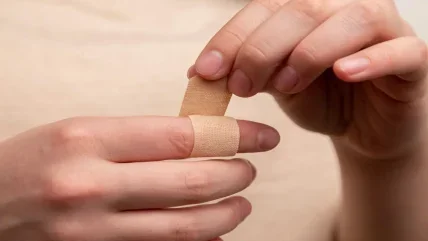
There’s an emphasis in many industries on easy-to-use, cheap alternatives to established products — and healthcare is certainly one of them. Jamie Bell takes a look at ZipStitch — a hospital-grade wound closure device that anyone can use to treat small cuts in seconds.
Whether it’s at home chopping vegetables, playing sports with friends, or cycling to work, minor cuts and flesh wounds can happen just about anywhere in day-to-day life.
Bigger, deeper wounds will often require a trip to the emergency room, and ultimately stitches — a painful, invasive procedure.
In the US, getting stitches is also expensive for anyone without health insurance. Cost range from $200 to as much as $3,000 in some cases.
However, any medium-sized or smaller cut is usually treated outside the healthcare setting using an adhesive bandage or plaster.
While these dressings can stop a small amount of bleeding — and protect against infection — they do little to close the wound and speed up the healing process.
US tissue-repair device company ZipLine Medical has developed a tool called ZipStitch, which combines the convenience of a plaster with many of the benefits provided by having a cut stitched by a doctor.
ZipStitch: The do-it-yourself wound closure device
ZipStitch is a small, adhesive device that is designed to be placed over cuts less than 4mm in width.
Once it is stuck down, the user simply pulls each of the four miniature straps on the device, tightening them and closing the break in the skin.
Because it is so small and light, ZipLine Medical believes its product is ideal for everyday first-aid kits, and can be useful for someone to have with them during a range of outdoor activities where minor injuries can often occur, including cycling, hiking or camping.
The company warns, however, that the wound must be cleaned properly and allowed to dry before application.
Not only does this reduce the risk of infection, but it ensures the device will stick to the skin and remain in place.
It is sold online for $29.99 as part of a pack including gauze pads to stop bleeding, alcohol wipes to clean wounds, and bandage to cover and protect the cut once ZipStitch has been applied.
The device is supposedly 12-times stronger than regular stitches and results in reduced scarring.
Although it can only be used to close wounds up to 1.5 inches in length. ZipLine Medical recommends seeking stitches in hospital to close larger cuts.
Unlike conventional sutures, ZipStitch is also non-invasive, which can reduce the chances of bacteria causing infection.
The company says it provides better protection than butterfly bandages and other adhesive plasters, repairing cuts faster and decreasing the likelihood of scarring.
Hospital-grade Zip technology
The device uses ZipLine Medical’s own Zip technology, which has been used by more than 500,000 people in the past five years, and by hospitals in 30 countries.
The California-based company says it delivers faster and less painful wound closure than established methods such as stitches or staples — with 95% of its patients saying they prefer Zip technology to these treatments.
Having proven to be safe and effective in several clinical trials, it gained FDA approval in 2017.
As well as treating minor, everyday injuries, Zip technology has been used to close wounds left by operations including knee and shoulder replacements — which, the company says, has resulted in reduced scarring compared with conventional stitches.
When used to close wounds following these procedures, a longer strip of the ZipStitch device is used to precisely align the edges of the incision.
The Zip structure also functions as a cage to offer extra protection from anything that might cause pain or reopen the cut.
Removing the ZipStitch can be done at home by the patient in some cases, and ZipLine Medical says this is as simple as pulling off a Band-Aid.
It is also less painful than removing stitches or staples, and leaves no holes in the skin.
As well as benefits for patients, the company claims the speed at which ZipStitch works can decrease healthcare costs and improve efficiency of patient care by reducing the number of follow-up appointments.
How ZipStitch compares to butterfly bandages and other wound closure devices
The main alternative to ZipStitch is the butterfly bandage — an adhesive strip designed to close small wounds by pulling the skin together.
These outperform ordinary plasters and are also small and light.
However, butterfly bandages cover a much smaller area than the ZipStitch device, meaning only cuts that are very short in length can be closed effectively.
There are several other methods for closing wounds without traditional stitches — German healthcare company McKesson uses a series of adhesive strips to do this.
Clozex Medical has developed a wound closure device that comes in several different lengths to treat a variety of cut sizes, and to cope with curvatures and raised areas on the skin.
Skin glue or “liquid stitches” can also be used to non-invasively hold the edges of a cut together. It can also be applied in addition to other wound closure methods like traditional stitches or adhesive bandages.
These other products are not do-it-yourself solutions, and require a healthcare professional to administer them.





